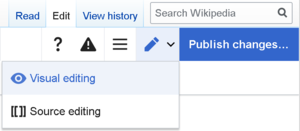Help:VisualEditor/User guide
Opening the visual editor
Getting started: the visual editor's toolbar
| The visual editor's toolbar appears at the top of the screen when you begin editing. It includes some familiar icons: | |
| Undo and Redo the changes you have made. | |
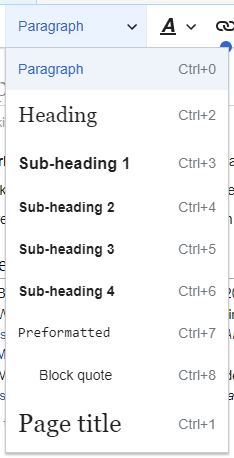 |
Headings pull-down menu: allows you to change how the paragraph is formatted. To change the style of a paragraph, put your cursor in the paragraph and select an item in this menu (you don't have to highlight any text). Section titles are formatted "Heading", and subsections are "Sub-heading 1", "Sub-heading 2", and so on. The normal format for text is "Paragraph". |
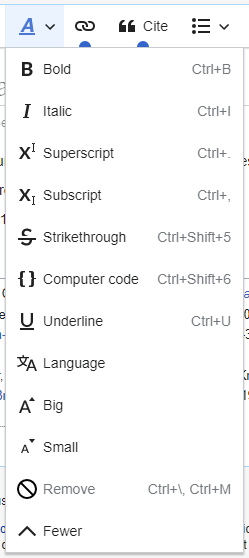 |
Formatting: Pressing the "A" opens a menu.
If you have not selected any text, then when you press the "A" to open the menu, and then select an item, that formatting will apply to the text that you start typing, from wherever your cursor is located. |
 |
Linking tool: The chain icon is the linking tool. Pressing on it (usually after selecting some text) opens the link dialog. |
 |
Cite menu: The "Cite" menu is used to add inline citations (also called "footnotes" or "references"). All projects have access to basic reference formatting and the ability to reuse citations by using this menu. It also gives users quick access to local citation templates, if these are enabled on their wiki.
(Instructions for adding local citation templates to the Cite menu at a specific wiki are available at mw:VisualEditor/Citation tool.) |
 |
⧼citoid-citefromidtool-title⧽ button: If the citoid service is enabled on your wiki, then you will see a ⧼citoid-citefromidtool-title⧽ button instead of a Cite menu.
The citoid service tries to fill out citation templates automatically. |
 |
Lists and indentation: The first two items allow you to format text as either a "Bullet list" or a "Numbered list". The last two items allow you to decrease or increase the indentation level of list items. |
 |
Insert: The "Insert" menu may be different on some projects. Below is a list of all options that may appear.
|
| Special character insertion: The "Special character" (Ω) icon is next to the "Insert" menu. When pressed, it displays a dialog showing many special characters. By pressing on a specific character, you place it into the text. These special characters include some standard symbols, diacritics, and mathematical symbols. (This list may be customized locally. See mw:VisualEditor/Special characters for instructions.) | |
| The Edit notices button displays any notices for the page. | |
 |
The Page options menu is to the left of the Publish changes button and the Switch editor menu. On this menu there is a button to open an Options dialog with the following (left side) tabs:
The tabs of the Options dialog are also displayed in the Page options menu and can be opened by clicking on it. Furthermore the Page options menu contains the button View as right-to-left and the button Find and replace which opens a dialog where you can insert characters, terms or Regular expressions you are searching for and those to replace them with, together with several buttons for options. |
| The switch to source editing button is next to the Publish changes button. It allows you to switch to the wikitext editor. | |
Publishing changes
| When you are finished editing, press the blue "Publish changes" button in the toolbar. If you have made no changes, the button will be disabled (grayed out). To cancel all your editing changes, close your browser window, or press the "Read" tab above the edit toolbar. | |
| Pressing the blue "Publish changes" button opens a dialog. You can then enter a brief summary of your actions, mark your edit as minor, and/or add the page to your Watchlist. The box for the summary is the equivalent of the Edit summary (Briefly describe your changes) field in the wikitext editor.
You can also review your changes using the "Review your changes" button to confirm that they will function as intended before saving your changes. This is similar to the "Show changes" button in the wikitext editor. The "Resume editing" button returns you to the page you were editing. You can publish all of your changes later. |
 |
Editing links
 |
Links can be added through the "Link" icon (links in a chain) in the toolbar, or by using the shortcut ^ Ctrl+K (or ⌘ Command+K on a Mac).
If you select (highlight) text and then press the "Link" button, that text will be used in creating the link. For a link that involves only one word, you can either select that word or just put the cursor within that word. |
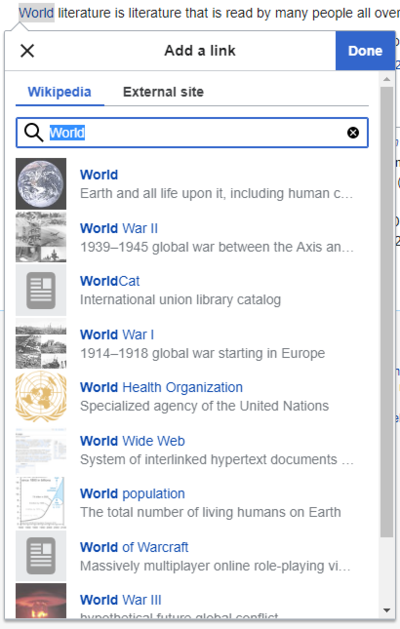 |
When you use either the button or the shortcut, a dialog will open in which you may type the link.
The link tool will try to help with internal links by searching for likely matches. |
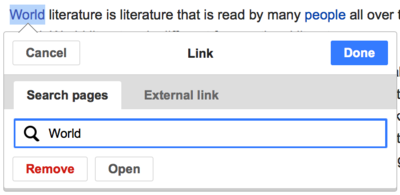 |
Once you have entered or selected the link, you complete the linking process by pressing ⌅ Enter or by pressing the "Done" button. Your link will immediately appear on the page, but as with other changes to the page, it will not be published until you publish the entire page. |
 |
To link to a web page on another website, the process is similar: Choose the "External site" tab, and enter a URL in the box. |
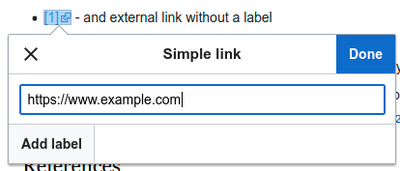 |
External links without labels look like this: [1]. You can add these by placing your cursor away from any word (e.g., after a space). Open the link tool by pressing on the button or pressing the shortcut keys. Type the URL in the box, and press the "Done" button to insert the link. |
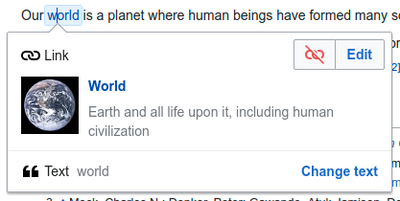 |
To change or remove an existing link, press within the text for that link, then press the "Link" icon that appears near it. The dialog will appear, for editing. You can also get to the dialog with the ^ Ctrl+K keyboard shortcut. When a link is selected, it appears as blue framed.
In the link editing dialog, you can then change where the link goes. You can also remove the link entirely by pressing the "Remove" button in the upper right corner of the dialog. You can also open the link's target in another window by pressing on the copy of the link in the dialog box. (You might want do this to check if an external link is valid.) If you want to exit the link label (the text displayed as a link) or continue to write after this link, you can press →:
To edit the link label of an existing link, press within the link label and type the new one. But if you want to replace the entire label, please note:
|
Editing references
- For further information, see Help using citation templates or Help using citoid's Cite button}}
Determining which system is in place | |
| Your wiki may use one of three footnote systems. The one shown on the right is the simplest system, where the "Cite" menu does not include any citation templates. If your wiki uses this system, then everything you need to know about footnotes is on this page. |  |
| The second system has the same type of "Cite" menu, but with several popular citation templates set up for quick access. If your wiki uses this system, then you will find more details at mw:Help:VisualEditor/User guide/Citations-Templates. | 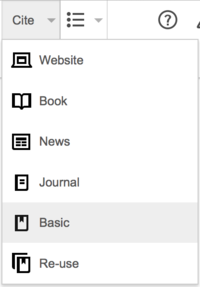 |
 | |
| In the third system, you again start by pressing the Cite button. Then a dialog box opens, which includes an automatic citation process using the citoid service. If your wiki uses this system, you will find more details at mw:Help:VisualEditor/User guide/Citations-Full. | 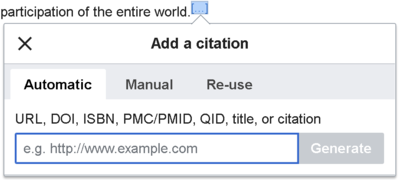 |
Editing an existing reference | |
| To edit an existing reference, press on it where it appears in the text (usually as a bracketed number). You will see either a "Reference" icon (bookmark) or an icon (and name) for the template that was used to create this reference. In either case, pressing on the "Edit" button will open a dialog where you can edit the reference. |  |
| For the "Reference" icon, pressing "Edit" opens the Reference dialog. To start changing the reference information, press on it.
Many wikis use templates to format references. If a template is used in your reference, then when you move your pointer over the reference information, all the information in that field will be highlighted . If a template was used and you press on the reference information, then the Template icon (puzzle piece) will appear with some information. Press on the "edit" button to edit the content of the template in the template mini-editor dialog. |
 |
| If what appears when you press on a reference is an icon for a standard template for citations (an example is at right), then pressing "Edit" will open the template mini-editor dialog. | |
| Inside the template mini-editor, you can add or remove types of information or change current content. Only fields (template parameters) that have content will show, initially. To add fields, press on "⧼visualeditor-dialog-transclusion-add-param⧽" at the bottom of the mini-editor. |  |
| Press on "Apply changes" when you are done. | |
Re-using an existing reference | |
| If the page already contains a citation that applies to the text you want to source, then you can choose to re-use that existing citation.
To re-use an existing reference, place your cursor in the body of the text where you want to add a new reference (number) for that citation. Then press on the "Re-use reference" item from the "Cite" menu. (Note: If your wiki has the third footnote system described above, you'll see a "Re-use" tab, in a dialog, instead of a "Re-use" item on the "Cite" menu.) |
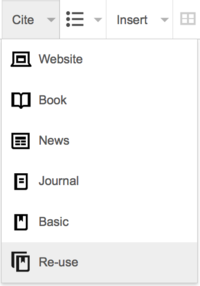 |
| In the Reference dialog, look at the list for the reference you want to reuse, and select it. If there are many references, you can use the search box (labeled "Search within current citations") to list only those references that include certain text. | 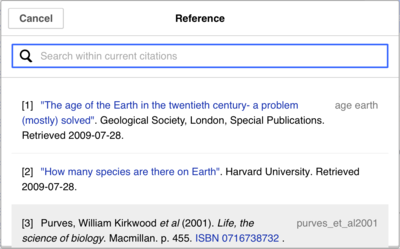 |
Adding a new reference | |
| To add a citation using the "Cite" menu, place your cursor where you want to add it in the text. Then select the appropriate citation type in the menu. |  |
Using the "Basic" citation | |
| Shown here is what you will see if you select the basic references item. In the Reference editor, you can add your citation, including formatting.
You can make the reference belong to a given group, although normally this is left blank. (This option is used to display groups of references with the "References list" tool.) |
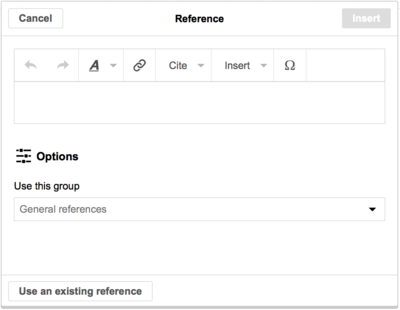 |
| In the Reference dialog, if you want to include a citation template, or any other template, in your new reference, press the Template icon (puzzle piece) in the "Insert" toolbar menu within the Reference editor. |  |
| Then, look for the template you want to use, add it and edit it as you would any other template. (See the Editing templates section, below, if you need more information about templates.)
After you are done editing your new template, press on "Apply changes" to return to the Reference editor, and "Apply changes" again to return to the page you are editing. |
 |
| If there isn't already a list of references on the page (for example, if you are adding the first reference for the page), you need to specify where the list of references, and their text, will be displayed to the reader.
Place the cursor where you want to display the references list (usually at the bottom of the page), open the "Insert" menu and press the "References list" icon (three books). |
 |
| If you are using several groups of references, which is relatively rare, you can specify the group in this dialog. Only the references that belong to that group will be displayed on the page at the location where you are placing the group.
The final step in the References list dialog is to press "Insert". |
 |
Using standard cite templates | |
| Your local wiki may have added extra citation templates to the "Cite" menu. If so, you have quick access to the most-used citation templates for your wiki. (Instructions for adding extra citation templates to your local wiki are available at mw:VisualEditor/Citation tool.) | 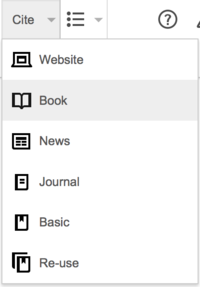 |
| Pressing on a template icon such as "Cite book" will take you into the template mini-editor for that template. Important information fields may be marked with an asterisk. While the most common fields will be shown, not all of them are required. |  |
| To add more parameters, scroll down in the template mini-editor and press on the "⧼visualeditor-dialog-transclusion-add-param⧽" option.
Press on "Insert" when you are done. |
 |
